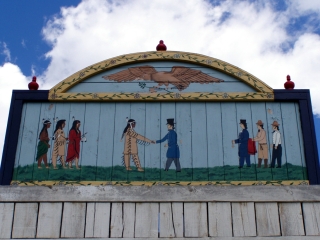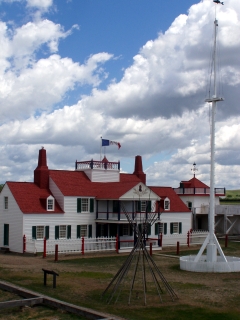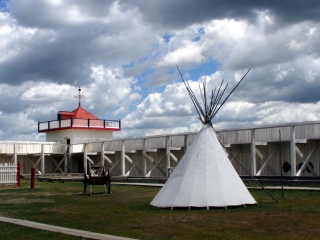NPS Website; Feasting and Fasting.
 WHAT IS IT?
WHAT IS IT?A reconstructed version of John Jacob Astor’s American Fur Company’s upper-Missouri Outfit Trading Post.
BEAUTY (3/10)
The reconstruction is well done and quite accurate due to the frontier paintings done by Karl Bodmer, George Catlin and John James Audubon, among others. Despite appearing in many pictures, Fort Union is not beautiful. The high gray-white walls are ugly but contrast nicely with the immeasurably large blue sky. The interior of the Fort looks much more hospitable. We were dubious about the mural above the entrance of the traders and the Native Americans shaking hands until we learned about the Site.
HISTORICAL INTEREST (6/10)
The Fort Union Trading Post encapsulates and interesting and forgotten period of western trade relations; a mutual relationship of trust, diversity, trade and acceptance. Fort Union was, despite the name’s confusion, a store located near the confluence of the Yellowstone and Missouri Rivers. The Post prospered from its building in 1828 to around 1850 when both the westward expansion and displacement of Indian tribes slowed business. Business was at its strongest until 1837 when the first wave of smallpox hit the area. Fort Union was dismantled in 1867 and the wood used to build a military post three miles downriver.
In the small window of prosperity, the white traders, mixed blood hunters, craftsmen, voyageurs and Natives worked in harmony to everyone’s advantage. Goods were traded, languages learned and people generally got along. As time passed, however, things changed.
CROWDS (6/10)
A few others made the trip to northwest North Dakota and we were able to talk for a half-hour with a costumed Ranger without distraction.
 EASE OF USE/ACCESS (2/5)
EASE OF USE/ACCESS (2/5)This Site is remote. The roads are two-lane, straight and close to nothing. Use a map; the route is circuitous and there are no signs. Viewing the Fort is easy and accessible to people in wheelchairs.
CONCESSIONS/BOOKSTORE (5/5)
Over 200 different titles ranging in topic from Lewis and Clark to Frontier Art to the History of Trade. Everything you need to know about this part of the world is here at the bookstore. Gab bought a coffee table quality book about the foods eaten along the trail by Lewis and Clark entitled Feasting and Fasting.
COSTS (5/5)
The Site is free and we were given coffee. Coffee that was being heated over a hearth, then poured with a ladle and served in a tin cup.
RANGER/GUIDE TO TOURIST RATIO (4/5)
There were three Rangers, one costumed, who were able to answer every one of our questions.
TOURS/CLASSES (7/10)
We received an introduction to the Fort and an explanation of trading practices between Native Americans and the American Fur Company as soon as we walked into the first room. The Ranger welcomed us, gave us some coffee then showed us just about every article in the trading office. What’s this? Why is this here? The Ranger/Trading Clerk really knew his stuff.
The Ranger at the bookstore seemed occupied and wasn’t as inviting as our friend the Clerk, but was still very knowledgeable regarding the books that filled the shelves. Browsing the bookstore offerings was nearly as good as viewing the small exhibit room also in the Bourgeois House.
The exhibit and self-starting video are showing their age. Neither are remarkable. What is, is the fact that nearly the entire reconstructed Fort is open to the public. You can explore wherever you like and around nearly every corner seems to be a Ranger supplied with answers to your questions.
What we learned is that Fort Union was an important liaison point - A space where for a brief period, very different cultures were able to engage in mutually beneficial trade. “Between exploration and exploitation” is how the Ranger/Trading Clerk defined that time. Fort Union was also a stop for the Corps of Discovery as Lewis and Clark traveled up the Missouri River.
 FUN (6/10)
FUN (6/10)We enjoyed talking in the trading office. Bringing home a new book is always a treat. We had fun trying to remember everything we learned about voyageurs and the fur trade from Grand Portage NM and about Plains Indian culture from Knife River and Pipestone. Fort Union Trading Post was one of those places where bits of information we have been gathering along the way start to fit together like pieces in a puzzle. I love it when that happens.
We were just a few days late for the Fort Union Rendezvous, a reenactment of an annual trade gathering (that never actually took place at Fort Union). But we bet the Rendezvous was a good time anyway.
WOULD WE RECOMMEND? (5/10)
If you find yourself in western North Dakota and don’t mind a drive, Fort Union is a pleasant destination. It will take you a while to get to the site, but it is one of the nicer stops on the Lewis and Clark Trail.
If you are visiting the Theodore Roosevelt National Park, Fort Union Trading Post NHS is an alternative way to spend a day. We packed up our camp in the South Unit, found a new spot in the North Unit, then took a day trip up to Fort Union. By the time we made it back to Teddy, the air had cooled enough to take a pleasant hike and Gab had a new book to read after supper.
TOTAL 49/80
www.usa-c2c.com
© 2004-06